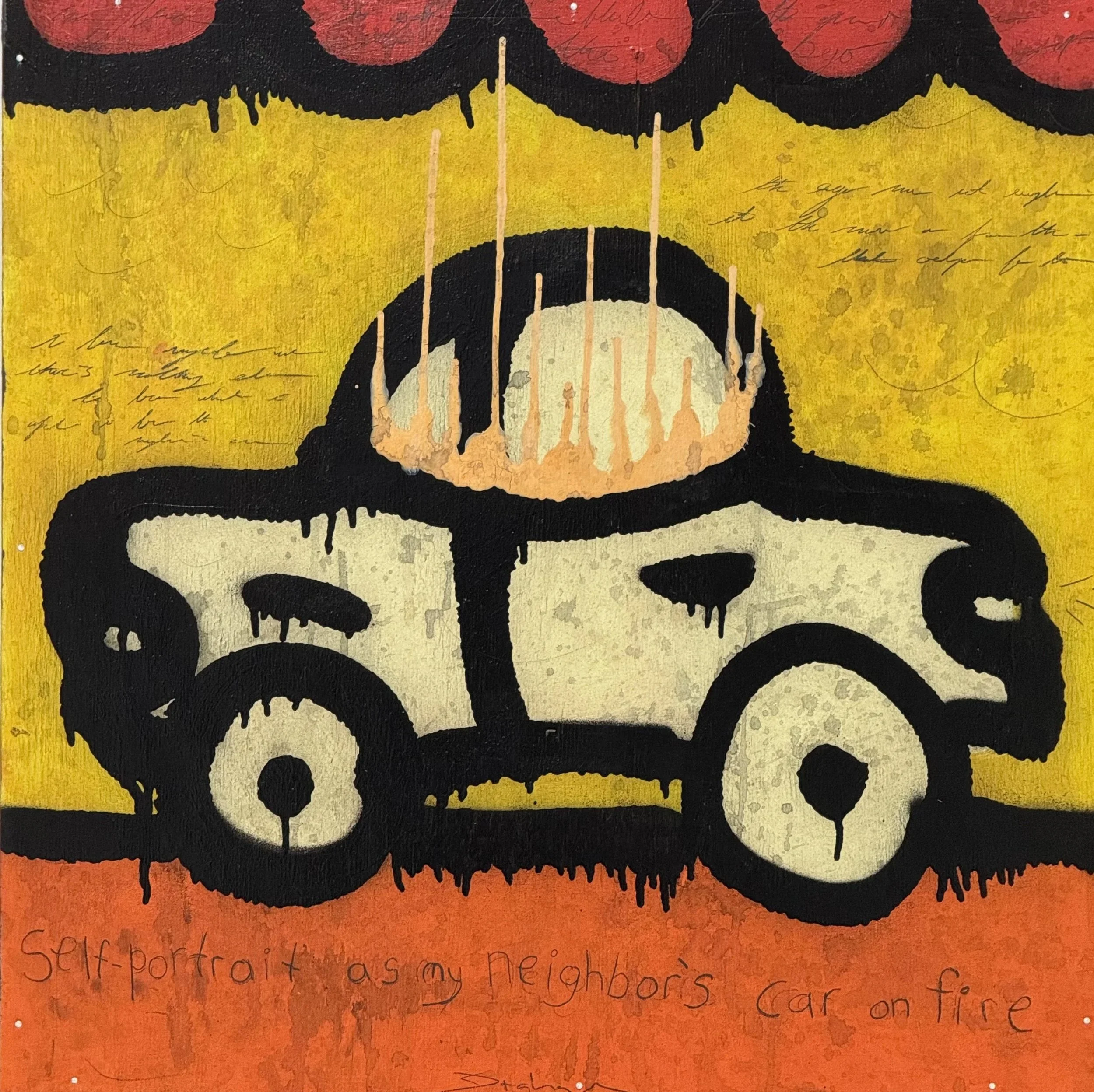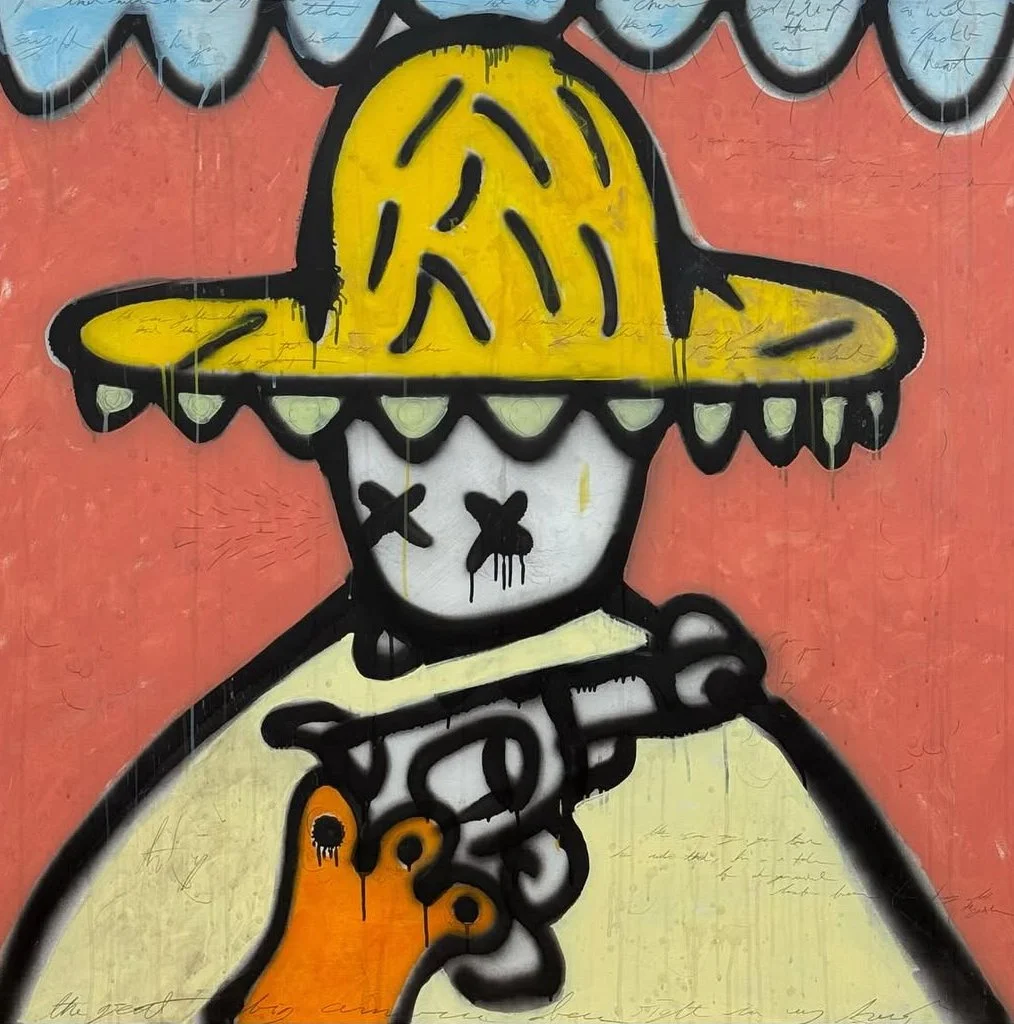Recent Works
A recent body of work rendered in simple forms and vivid colors, informed by the aesthetics of Outsider and Pop Art, displaying a witty, humorous correspondence with the contemporary world
.
Self-Portrait as my Neighbor’s Car on Fire
In this provocative self-portrait, the artist renders himself not as a face or figure, but as a burning vehicle. The work examines the entanglement of contemporary identity with consumer culture, specifically how…
-
…personal meaning and self-worth are increasingly mediated through objects—what we drive, wear, or own.
Here, the automobile becomes both mirror and metaphor: a symbol of freedom and power in the American psyche, yet also a source of repression. The fire suggests a rupture, a moment when the glossy surface of modern life gives way to something raw and uncontained.
Self-portrait critiques the psychological structure of modern cities, where life is divided into zones—residential, commercial, industrial—demanding emotional and social compartmentalization. This spatial order reflects deeper repression, where conflicting aspects of experience are set aside for control. Informed by psychoanalytic concepts, the painting suggests what happens when the repressed resurfaces—when containment fails and the unresolved breaks through.
At once personal and political, Self-Portrait offers a darkly satirical meditation on identity, consumerism, and the volatile infrastructures that define contemporary life.
24” x 24” House paint, acrylic on wood panel
No More Heroes Please
No More Heroes Please presents a stark, roughly painted figure beneath a sky of orange and red, the final sunset of the Hero. Clad in a wide-brimmed hat and….
-
…wielding oversized guns, the character stands alone in a green field—both out of place and out of time. The crude rendering of the form suggests a distortion or unraveling of familiar archetypes: the outlaw, the soldier, the savior.
The work engages with the mythology of heroism—particularly its decline, exhaustion, or absurdity in the modern world. The exaggerated weapons and apocalyptic sky hint at violence, bravado, and spectacle, while the figure’s emptiness gestures toward disillusionment.
The title itself reads as both elegy, plea, and indictment: a lament for vanished ideals, and a critique of the cultural need for larger-than-life figures to solve systemic problems.
Set against the calm green of the field, the painting juxtaposes menace with mundanity, chaos with calm. In doing so, it invites viewers to question not only who we call heroes, but why we construct them in the first place—and what remains when they are gone.
48” x 48” House paint, spray paint, acrylic, pencil on wood panel.
The Great Big American Dream
Right Here in my Hand
In this striking work, a cartoon-like figure with a large yellow hat and X's for eyes holds a gun—a blunt, almost childlike rendering that belies the complex cultural tensions at work…
-
The oversized hat evokes a time when headwear marked social standing. In earlier American life, one’s hat could signal one’s place in the class hierarchy. Here, the exaggerated yellow hat distorts that tradition—its size and color absurd, ironic, almost clownish—evoking a warped dream of status or significance.
The gun, meanwhile, remains one of America’s most enduring icons: symbol of freedom, power, and authority. Yet the figure's eyes are replaced by X’s—an image of death, blindness, or erasure—suggesting that what was once an aspirational myth has grown hollow or self-destructive.
The works offer a meditation on the myths of self-reliance, class mobility, and rugged individualism that underpin the so-called “American Dream.”
48” x 48” House paint, spray paint, acrylic, pencil on wood panel.
Detective Convention (Cleveland)
In Detective Convention, a series of detective characters centers are multiplied as the human form is reduced to a flat, watchful silhouette. These anonymous, hat-wearing forms recall the popular figure of the…
-
…television and movie sleuth, but stripped of narrative specificity. Displayed en masse, they evoke the omnipresence of modern surveillance.
By using bright, carnivalesque color, combined with a childlike simplicity, the works subvert the cold, technological sheen of contemporary security apparatuses. The cartoon bodies become cute stand-ins for institutional watchers, their innocent forms hinting at the pervasiveness and deceptive power of ubiquitous monitoring and surveillance.
In this way, Detective Convention reflects our uneasy coexistence with surveillance culture—where phrases like “for your protection” blur the line between safety and control.
At once humorous and haunting, Detective Convention invites viewers to consider the psychological terrain of a world where watching—and being watched—is a condition of everyday life.
24” x 24” House paint, acrylic, pencil on wood panel.
Another Portrait of my Second Ex-Husband
Rendered in gaudy pinks, yellows, and reds, this close-up of a cartoon-like pistol transforms an object of violence into something strangely playful—yet still unsettling.
-
Painted on a brown paper bag using inexpensive materials, the work embraces the raw immediacy and emotional honesty often found in outsider art.
The weapon here functions not only as a literal object but also as a stand-in for emotional volatility and domestic conflict. The title—Another Portrait of My Second Ex-Husband—positions the firearm as both metaphor and caricature. It nods to a cultural archetype: the ex-husband as a figure of past turmoil, misfired affection, or toxic masculinity. The absurdity of depicting a person as a gun is part satire, part exorcism—recasting personal history through dark humor and exaggerated symbolism.
In this way, the work critiques both private experience and broader social dynamics, inviting viewers to consider how objects, relationships, and gender roles get mythologized—and weaponized—within personal memory.
36” x 24” House paint, tempera, pencil on brown paper bag.





